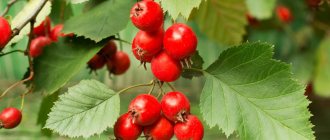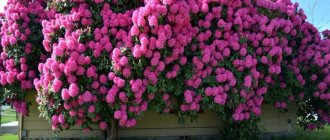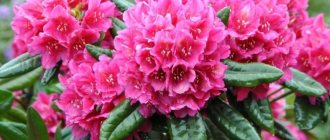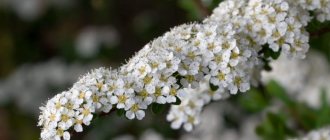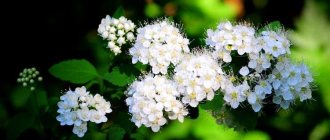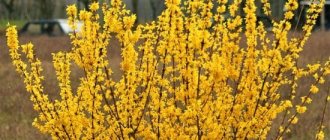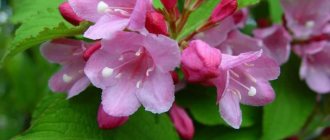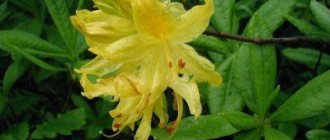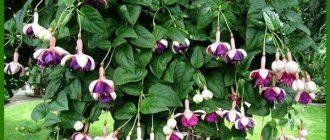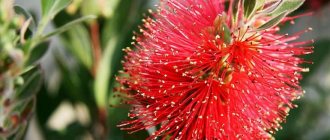Planting rhododendron in open ground
There is nothing complicated about the operation. Anyone who has planted any other shrub can handle placing rhododendron on the site.
Choice of time and location
The plant needs diffused light or partial shade. In bright sunshine, culture:
- blooms poorly;
- the leaves wither, which impairs photosynthesis and nutrition;
- As a result, the shrub winters worse and may freeze.
But in the deep shade, the owners will have to wait a long time for the first buds. There, flower buds will form only on an adult plant.
If next to the bush there used to be a shelter in the form of a hedge or a tree with an openwork crown, and then it was removed, it’s not scary. Rhododendron easily tolerates transplantation.
The appropriate time for surgery depends on the region. In the south, it is done in the fall, as soon as the heat subsides, but no later than a month before the first frost. This way the plant will have time to take root and will immediately begin to grow at the beginning of the season. If rhododendron is planted in a warm climate in the spring, sudden heat can destroy the shrub before it takes root.
In the middle zone and cool regions, the plant is placed on the site at the beginning of the season, as soon as the snow thaws and the ground warms up a little. It's still a long way from the heat. But if the operation is carried out in the fall, planting rhododendron in open ground may end in failure - the plant simply will not have time to take root before frost.
You can choose trees or shrubs with a deep root system as neighbors for culture:
- apple tree;
- pear;
- pine;
- spruce;
- larch.
They take water and nutrition from different layers of the soil, which eliminates competition. Plants with roots lying close to the surface should not be planted next to rhododendron:
- birch;
- willow;
- maple;
- oak.
How to plant shrubs correctly
The pit for the plant is prepared in advance; its diameter should be at least 2 times the volume of the root system. If the soil on the site is dense, clayey, the depth is increased by 15-20 cm, the “extra” space is filled with drainage - although rhododendron likes to drink, it cannot tolerate stagnant water.
The planting mixture is prepared from fertile soil and acidic peat; its pH should be 3.5-5.5.
A good addition would be pine cones or pine litter from the nearest pine forest - the more, the better. Mycorrhiza will fall into the pit along with the needles.
Landing algorithm:
- The plant is removed from the container.
- Gently crush the earthen lump with your hands to release and straighten the outer roots.
- Place the rhododendron in the center of the hole so that the root collar is flush with the edge. If it is higher, the plant will dry out, if it is lower, it will dry out.
- Fill the free space with planting mixture.
- They crush the substrate.
- Water generously until water stops being absorbed.
- Mulch with acidic peat or pine litter.
Pest and disease control
The main scourge of all rhododendrons is the rhododendron bug, which leaves whitish spots on the leaves. It is a large parasite, up to 3-4 mm in size, so it can be noticed even this way. The bug lays eggs on the back of the plates, and new offspring wake up after wintering.
Rhododendron also faces more typical problems - spider mites or weevils. Thrips, garden beetles or narrow-winged moths may appear. The principle of operation is the same - timely treatment of seedlings with insecticides.
If yellow spots grow on the tips of rhododendron leaves, this is most likely mixed chlorosis. The most common reasons are lack of fertilizers or stagnant water. Another indicator of nutritional deficiency is red-brown spots along the veins. And if the rhododendron is too cold, the leaves may even die off.
Photo: mm-ewm.ru
Outdoor care
Rhododendron, which was planted this season, must be sprayed by sprinkling, in dry weather - daily. Later, the procedure is also indicated for the plant, but not so often. The soil should be moist, but not waterlogged or stagnant.
Weeds should be pulled out by hand to avoid damaging the root.
During watering, the liquid should saturate the ground to a depth of 30 cm. Soft water should be used for rhododendron. If the site has a centralized water supply or a deep well, it needs to be left for a day, adding 1 kg of peat or 3-4 g of citric acid to a bucket.
Trimming
When cutting a plant, the main thing is to preserve the apical buds. Otherwise, the rhododendron bush will form a beautiful one, but there will be no flowering.
Sanitary pruning should be carried out in spring and autumn - remove dry branches. If the owners want, the plant can be used to make a garden bonsai. In other cases, the shrub rarely needs shaping - it is already beautiful and compact. Except that:
- a plant of a certain size is needed on the site, for example, several specimens form a continuous array;
- the rhododendron is old and needs to be rejuvenated;
- the bush is too tall.
Plant pruning is done in the spring. The wounds are immediately covered with garden varnish. Wilted inflorescences are removed.
Top dressing
Caring for rhododendron does not require frequent or repeated feeding. The plant reacts poorly to them, since in nature it receives poor nutrition.
In the spring, when growth processes resume, the flower can be stimulated with a preparation with a large amount of nitrogen, but only once. Significant doses of nitrates cause not only the rapid development of greenery, but also the shedding of already formed buds from the plant.
After flowering, the rhododendron in the garden is fertilized again with a fertilizer specially designed for the crop or blueberries. In the middle zone it will be around the beginning of June, in the south – earlier.
The plant cannot tolerate organic animal matter - mullein, bird droppings or their infusions.
At the end of summer or beginning of autumn, rhododendron is fertilized with potassium monophosphate or Pekacid. Both preparations do not contain nitrogen and help rhododendron wood to ripen and overwinter better.
In case of chlorosis, which more often occurs in regions where the “native” soil has an alkaline or neutral reaction, the crown of the bush is additionally sprayed with a chelate complex.
Prevention of diseases and pests
In addition to chlorosis, rhododendron suffers from diseases:
- rust;
- root rot;
- spotting;
- cancer.
Insects include:
- scale insects;
- mealybugs;
- spider mites;
- weevils;
- rhododendron flies;
- bedbugs;
- slugs;
- snails
Diseases are treated with appropriate fungicides, and pests are eradicated by spraying with insecticides. Prevention:
- treatment with copper-containing preparations;
- regular sanitary pruning;
- keeping the tree trunk area clean;
- correct agricultural technology.
Care after flowering
It is very important, especially for young rhododendron bushes, to remove all faded buds. They are simply plucked or torn from the plant. If this is not done, the setting and ripening of seeds will draw away nutrients, which will prevent the growth of the root system and flowering next year.
The rhododendron plant, after withering and removing old buds, gives a second wave of growth. When there are no new shoots in the summer, something is wrong.
Around mid-July, flower buds begin to form at the ends of young branches. At this point, the plant should be fed with a full mineral complex.
In late summer or early autumn, rhododendrons are given nitrogen-free potassium-phosphorus fertilizers. This allows the wood to ripen better and helps the shrubs survive the winter.
All plants need moisture recharging, but especially rhododendrons. In dry autumn, it is often watered, always by sprinkling, so that the branches are also well saturated with water.
Cut off all dry shoots on which pests and pathogens overwinter. Pull it out by hand so as not to injure the root and weed residues. They clear the tree trunk circle of fallen leaves - you can use them for mulching, but only if the plant is absolutely healthy.
Rhododendron care
In spring, the alpine rose is protected from the sun. They are covered with cloth. Gauze will do. Select the correct soil moisture regime. During drought, rhododendrons are watered several times over 7 days.
The shrubs will sprout shoots in the fall if the weather remains warm and humid. In winter, such growth freezes out because it does not have time to grow stronger. To stop active growth, alpine roses are treated with a 1% solution of potassium sulfate or monophosphate. The procedure is carried out in dry weather. This causes lignification and guarantees the formation of buds for the next season. After treatment, watering is stopped completely.
For the winter, the alpine rose is covered if severe frosts are expected. To do this, make a frame from metal rods around a rhododendron bush, wrap it with spunbond and secure it with twine.
You cannot loosen the soil at the roots of the bush. Weeds should be removed manually, without using metal tools.
Read about how to extend the life of fragile plants here.
Rhododendron pruning
The Alpine rose has the correct outline, so it does not need to form a crown. Dried branches are periodically removed from it. Pruning is carried out to rejuvenate the bush and regulate its size. They do this in the fall. Remove 1/3 of the length of the shoot.
If the thickness of the branches is less than 4 mm, the sections are treated with garden varnish. After pruning, leave 3/4 of the entire bush.
Rhododendron blooms profusely once every 2 years. To ensure that the shrub produces many buds each year, the wilted ones are removed at the end of flowering. The procedure provides an influx of strength to the bush and stimulates the formation of buds.
Plants cannot be pruned in spring.
Features of care and planting in the Moscow region
The main thing is to choose the right species that can withstand the Central climate well. Rhododendrons suitable for the Moscow region:
- Vaseley;
- Tree-like;
- Daursky;
- Yellow;
- Golden;
- Ledebura;
- Kamchatsky;
- Canadian;
- Katevbinsky;
- Short-fruited;
- Pukhansky;
- Protistum;
- Rusty;
- Smirnova;
- Schlippenbach;
- Japanese.
Japanese salmon variety
Information about zoned varieties and hybrids can be obtained upon purchase.
The plant is planted in the Moscow region in the spring - the bush will have time to take root before winter. Choose a semi-shaded place, protected from cold winds. At the end of the season, rhododendron must be mulched and covered with non-woven material. The rest of the care is the same as described above.
general information
Despite the fact that the name rhododendron literally translates as “rose tree,” it has nothing to do with roses. The only thing they have in common is the variety of varieties and fabulous beauty during flowering. And rhododendron belongs to the heather family.
It is most commonly found in the Himalayas, Southeast Asia and Southern China. Some species grow in Japan, North America, New Guinea and Australia. But they are all very different, from tiny creeping shrubs to entire trees.
The length of rhododendron stems in the wild can reach an astonishing 30 m. The flowers can be quite miniature, and sometimes exceed 20 cm in diameter. But there are also compact varieties that love to be grown on windowsills.
Photo: shark-media.ru
How to replant rhododendron
Garden rhododendron easily tolerates moving to another place. The main thing is to choose the right time and dig up a plant with a large lump of earth. The operation is carried out:
- in the south - in autumn;
- in the middle zone or cooler regions - in spring.
First, prepare a planting hole, then dig up the plant, loosen it, and transfer it on burlap to a new area. If necessary, expand the hole so that the lump fits in freely and there is some space left.
Planting is done at the same depth as before. The root collar of a rhododendron cannot be buried or raised.
The plant is watered abundantly with a solution of a root formation stimulator. Mulch and be sure to provide shade for the first time.
History of the garden plant rhododendron
One of the most striking representatives of the Heather family, rhododendron (Rhododendron), is represented by shrubby plants and trees. If you read the species definition, there are:
Gorgeous rhododendron bush
- evergreen;
- deciduous;
- semi-deciduous.
Different sources describe different numbers of plants in this genus. On average, it unites from 800 to 1300 plants, including azaleas, which are very popular in indoor floriculture.
For reference: among domestic flower lovers it is the azalea that is usually called “indoor rhododendron.”
Reproduction methods
Seed propagation is possible only for species or varieties. Hybrids are propagated vegetatively. If you need few new plants, it is better to make several layerings so as not to bother with cuttings.
Seeds
Rhododendrons are sown in wide shallow bowls on the surface of a damp peat-sand mixture. Sprinkle with clean washed and calcined sand. Cover with glass and keep in light at high humidity and temperature. Ventilate daily.
Rhododendron seedlings usually hatch within a month. After 2 true leaves appear, they are picked, grown in a greenhouse for the first year, then transplanted into a schoolhouse. They will bloom in the 6-8th season.
Cuttings
Semi-lignified cuttings are suitable for propagating rhododendrons. They are cut into 5-8 cm pieces, all leaves are torn off except the top ones, the lower part is treated with a stimulant, and rooted in a mixture of peat and sand. You can use a greenhouse with high temperature and humidity, or cover the planting with a glass cover.
The lower shoots will appear:
- in deciduous species - after 6 weeks;
- evergreen rhododendrons produce roots after 3-4.5 months.
The cuttings are grown in a mixture of peat and pine litter (2:1). In winter, they are kept in good light and a temperature of 8-12 ° C. In spring, the seedling box is buried in an area in partial shade. They are transplanted to a permanent place after 2 years.
Bends
In the spring, a strong shoot located in the lower part of the bush is selected on the rhododendron. It is bent down and buried at least 15 cm deep. The top is tied to a peg, and the part of the shoot directed towards the mother plant is pinned to the ground so as not to be accidentally pulled out.
Water abundantly and often. The next season, the cuttings are separated from the bush and transplanted to a permanent place.
Chemical composition
It is important to know about rhododendron that it is a poisonous plant. The dangerous properties are associated with a substance contained in the composition called andromedotoxin (also called rhodotoxin, acetylandromedol).
Varietal rhododendron at home
This cyclic diterpene is classified as polyhydroxylated. According to the mechanism of action, it is comparable to neurotoxins and is characteristic of almost all Heathers.
The action of this toxic substance is based on the ability to disrupt the functioning of cellular receptors. Initially, the central nervous system is excited, and then comes into a state of depression. This mechanism of action is quite capable of leading to death. This information is not known to everyone, but it eliminates all doubts about whether the rhododendron bush is poisonous or not.
How to cover a rhododendron for the winter
It is important to cover the plant correctly and on time - it forms flower buds at the ends of the shoots in the previous season. The shrub can withstand low temperatures well, but is afraid of the cold winter wind and the bright sun reflected from the snow.
The greatest danger to a plant when caring in open ground is loss of moisture during the dormant period. It is equally contraindicated for deciduous and evergreen species - if they dry out, flower buds will form next time in the new season, and will bloom in a year. And this is the best option.
Not only the ends of shoots, but also entire branches or the entire plant can die from moisture deficiency.
The next problem is that under the bright sun, not only transpiration is activated. The crown heats up, the buds receive a signal to awaken (in rhododendron, growth processes resume early), and the root is in frozen soil and cannot provide the plant with moisture or nutrition.
So not only in cold regions, but also where there is usually snow in winter, all plants need to be covered. Even when growing rhododendrons in places protected from the wind. If the shrub is planted in partial shade, this will not completely protect it from the drying sun.
Hilling
The agrotechnical technique hilling is the rolling down of the projection area of the plant crown with soil, carried out during loosening. But the root system of rhododendron is superficial; its trunk circle needs to be mulched and not hilled, so as not to damage the underground part.
It is recommended to use litter from healthy coniferous trees - usually pine is used; covering material cannot be taken from under fir trees.
The bark is suitable - it is sold in garden centers already treated for diseases and pests by the manufacturer. Not the worst option is high-moor peat.
To preserve the root system of plants, you need a layer of mulch covering the entire crown projection area:
- for low-growing shrubs up to 50 cm – 5 cm;
- large rhododendrons – 20 cm.
Covering plants with non-woven material or spruce branches does not replace mulching of the root zone. These agricultural techniques complement each other.
Protection with agrotextiles
You only need to rush to cover the plants planted this season. Well-rooted shrubs can easily withstand frost of -10° C. If you build protection earlier, they will freeze, which is even more dangerous than frostbite and is almost guaranteed to lead to the death of the plant.
Hardening the rhododendron by letting the temperature drop several times to -2-3° C is even useful if the moisture charging is carried out correctly. There is no need to be afraid that the leaves of evergreen species will become soft, curl, droop, or press against the branches. When the weather warms up, the turgor will return and they will gradually straighten out.
To cover plants, use white or beige spunbond or lutrasteel. As an auxiliary material for additional insulation in cold regions - jute or burlap.
What needs to be done in advance is to install the frame over the rhododendron - sticking the ends into the frozen ground is difficult. It should be made of durable steel, preferably in the form of a cone (so that snow rolls off). But for tall plants this is problematic; owners often stick a pole close to the root collar, around which they build a pyramid.
As soon as the temperature drops below minus 10° C, a cap made of non-woven material is pulled over the frame. The ends are secured with staples or pressed down with stones.
In spring, there is no need to rush to remove the cover from the plant. They do this only after the snow has melted and immediately begin to water and spray the bush. If the evergreen rhododendron has lost its plates, and the deciduous one has clearly shrunk, daily dosed irrigation of the crown and root zone can revive the shrub. It will not bloom for several seasons, but it will survive.
Covering with branches
The rhododendron is covered with spruce branches and tied with twine. The method is good for small shrubs. For large plants, if possible, you can bend the branches and pin them to the ground, but so that the wood does not crack.
Creeping types of rhododendron, low-growing or young plants are sometimes completely covered with leaves, preferably oak leaves. And they are covered with agrofibre so that they do not fly apart. Cellophane cannot be used - it does not allow air to pass through.
But it is recommended to do this if the owners are sure that a snowy winter will not give way to thaws. Wet leaves are not the best shelter for rhododendron, although it suffers precisely from loss of moisture.
Decorative use
Not a single gardener, having once seen this flowering shrub, will deny himself the pleasure of planting it on his site. Many believe that it is incomparable to any other decorative flowering plant. And if many call the rose the queen of the garden, then the rhododendron is deservedly called its king.
The year a young rhododendron blooms after planting is influenced by many circumstances - applied fertilizers, weather conditions, care. A high decorative effect can be achieved already from the first year of planting seedlings by purchasing large-sized plants aged 5-8 years with a formed crown and flower buds ready to bloom.
Also, the effect in decorative use largely depends on exactly how the plant is located on the site.
Important! Since rhododendron grows for a long time, you need to buy either mature bushes, or immediately expect that it will show itself in all its glory decades later.
Types and varieties
Many rhododendrons do well as garden plants. There is plenty to choose from - there are dozens of species and hundreds of varieties of rhododendrons in cultivation. The article presents descriptions and photos of only some.
Rhododendron Rusty
Rhododendron ferrugineum is an evergreen shrub native to the mountains of Southern Europe. It is considered the type (nomenclatural) species of the genus. It grows slowly, in cultivation it adds about 3 cm annually, reaches a height of 70 cm with a crown diameter of 1 m. In particularly favorable conditions, the growth of an old well-groomed plant can be 120-150 cm.
The branches are dense, grayish-brown, first stretch upward, then bend at the base, which is why the bush becomes wide and squat. The leaves are dense, leathery, ovate, their length and width are 3-4 and 1.5 cm, respectively, the front side is shiny, the back side is covered with rusty scales of glands.
Rhododendron blooms late, in the middle zone around the second half of June, throughout the month. The corollas are bell-shaped, usually reddish-pink, rarely white, up to 2 cm in diameter, collected in 6-10 pieces.
This is one of the most unpretentious types of rhododendron. In Finland and the Nizhny Novgorod region it winters well under snow.
Rhododendron Tree
Rhododendron arborescens grows in the eastern United States in the Appalachian Mountains. It is a deciduous shrub up to 3 m high, giving an annual growth of 5-10 cm. In cultivation, a 15-year-old plant reaches 0.5-0.8 m with a diameter of about 80 cm.
The leaves are petiolate, lanceolate or obovate, 4-8 cm long and 1.5-3 cm wide. During the active growing season they have a bright green color, and in the fall they turn purple or yellow with orange.
The flowers open in July on a leafy shrub; they look like funnels, white and pink, up to 6 cm in diameter. The buds are collected in groups of 3-6, the stamens are long.
This type of rhododendron can be grown in the middle zone. In particularly harsh winters, flower buds freeze out on the ends of the shoots not covered with snow.
Rhododendron Daurian
Rhododendron dahuricum occupies vast areas east of the Altai Mountains. This is a very plastic species, which, depending on the place of growth, can easily be confused with rhododendrons Sikhotinsky, Small-leaved, Lidebur.
It is a branched shrub with a height of 50 cm to 2, in rare cases – 4 m with gray bark and straight ascending shoots. The leaves are small, up to 3 cm long, young are pale, mature - dark green. In autumn they acquire a reddish tint and partially fly off.
The flowering of Daurian rhododendron lasts about 20 days. Buds appear on the plant before young leaves. The corollas, 2-4 cm in diameter, are funnel-shaped, pink-violet; in the sempervirens form, they are purple-inky. In the long autumn, re-blooming is possible.
This is one of the most frost-resistant types of rhododendron - it can withstand temperatures down to -45° C.
Adams rhododendron
Rhododendron adamsii is an evergreen plant native to the Far East and the foothills of Tibet. It is a shrub up to 50 cm high with dense, hairy branches.
The leaves are matte, small, oval, about 2 cm. Flowers of all shades of pink, up to 1.5 cm in cross section, are collected in corymbs of 7-15 pieces.
Rhododendron japonica
Rhododendron molle subsp. Japonicum is a subspecies of the Soft rhododendron. It is a deciduous shrub with a wide crown up to 2 m high, annual growth is 7-10 cm. The bark is gray, the branches are dense, they can be bare or woolly. The leaves of the plant are lanceolate, length and width are 4-10 and 2-4 cm, respectively.
Rhododendron flowers appear simultaneously with young plates or earlier, collected in 6-12 pieces. They look like a wide bell with a diameter of up to 8 cm. The color is red with a salmon, brick, orange tint and a canary spot in the center.
The species is frost-resistant, can withstand down to -26° C. Popular varieties:
- Grandmother;
- White Prince;
- Shniperli.
Rhododendron Caucasian
Rhododendron caucasicum forms dense thickets. The skeletal branches of the plant reach a length of 1-2 m, but the bush often spreads, so that the height above the ground level may not exceed 50-60 cm.
The leaves are oblong, pointed, dense, up to 10 cm long. The flowers are bell-shaped, yellowish-white with a lettuce spot in the center, collected in clusters of 8-12 pieces. The corolla of the plant is no more than 4 cm in diameter. It has a number of forms with pale pink, plum, golden or straw flowers.
Popular varieties:
- Pictum;
- Cunninghams White;
- Christmas Cher;
- Chevalier Felix de Savage.
Rhododendron Hybrid
Rhododendron hybriden is an artificially created group of cultivated plants based on natural species. It is distinguished by compact dense bushes, spreading or erect, sometimes creeping, with medium or slow growth.
The leaves of Hybrid Rhododendron can be glossy or matte, smooth, hairy, evergreen and fall off in the winter. Small or relatively large plates are usually entire, dark green, lanceolate, oval, depending on the plant variety.
Variety Blutopia
The flowering is more luxuriant than that of the wild original species of rhododendrons. The color can be bright, catchy or pastel. The corollas are usually collected in dense, numerous groups. Hybrid forms bloom from early spring to mid-summer.
Popular varieties:
- Lord Roberts;
- Madame Masson;
- Marcel Menard;
- Goldbouquet;
- Rasputin;
- Horizon Monarch;
- Anna;
- Blue Peter;
- Safrano;
- Libretto;
- Rocket;
- Tarragona.
What colors are rhododendrons?
Rhododendron is the largest shrub in terms of diversity of species. Therefore, you can easily choose a bush that matches the color of your landscape design. For example, if you need a blue, lilac or purple bush, inflorescences of these shades are:
- attractive;
- Katevbinsky;
- dense;
- merrin;
- Canadian;
- Pontic.
If you prefer red flowers, you should pay attention to the inflorescences:
- Kamchatka;
- blood red;
- Albrecht;
- rusty.
Pink inflorescences in:
- Canadian;
- Daurian;
- the largest.
The Japanese variety will delight you with salmon and orange flowers.
And here are the yellow flowers:
- nail-shaped;
- yellow;
- golden.
The following inflorescences will delight you with white and cream flowers in the garden:
- short-fruited;
- Atlantic;
- sticky;
- Adams;
- tree-like;
- Caucasian.
You can always choose a variety that will optimally fit into the overall landscape design of any site.
Mulching and watering
Rhododendrons must be constantly watered, even after flowering and until late autumn. In November, do moisture-charging watering so that the moisture penetrates deep into the ground and nourishes the roots. Some gardeners also continue to water rhododendrons even in winter, but less frequently.
After watering, the soil must be mulched. To do this, take pine needles or pine sawdust, a mixture of fallen garden leaves and soil. Mulch will serve as a good cover for the tree trunk and roots for the winter.
If you plan to transplant bushes in the fall or plant new ones, the seedlings must be well watered and mulched with a high layer. The mulch should be highly acidic – coniferous is best.
Replanting bushes in the garden
Rhododendron transplantation in summer or spring is carried out taking into account one important nuance - the flowering plant cannot be disturbed. The bush will survive the rest. Experienced flower growers engage in replanting at any time of the growing season - spring, autumn, summer.
How to correctly move a bush to another place:
- If the soil meets the desired pH level, you can immediately dig a hole. Its dimensions are 50 cm deep, 60 wide. This applies to a small bush, the root system of which is placed in a hole with a reserve.
- While the hole is being created, the rhododendron can be placed in acidified rainwater to prepare the roots for planting.
- Drainage is laid at the bottom - you can fill it with red brick or pour purchased expanded clay - it accumulates moisture and is able to gradually release it to the roots.
- A layer of soil with pine sawdust, rotted needles, peat and sand is poured on top of the drainage.
- The plant is installed in the hole so that the root collar does not go deeper than it was in the previous place.
- The soil is gradually added and compacted so that large air pockets do not appear. It is important to squeeze the soil near the roots so that they immediately begin to receive nutrients.
- After planting, the plant is watered with warm acidic water. You can soften the water by adding high-moor peat to it a day or two before watering.
After planting, the bushes are strengthened with support by driving in 3–4 pegs and entangling them with wire or rope. While the plant takes root, and this happens depending on the variety from 1.5 to 5 months, the support will protect it from the wind. After rooting it can be removed.
Video: Flower care
Juice from petals of rhododendron dahurian
Scientists have discovered the following beneficial substances in the petals of the plant:
Daurian rhododendron
- fructose;
- phytoncides;
- resins;
- essential oils;
- vitamins A, C, E.
It is not surprising that the juice from this amazing plant, which is also called rosemary, is used in medicine. In combination with fresh cream, juice obtained from the petals treats:
- stomach and duodenal ulcers;
- thrombophlebitis;
- wound surfaces.
Having learned what rhododendron is and having become familiar with all the growing and care conditions necessary for the plant, you can decide whether it is worth planting it on your site.
What does autumn care consist of?
Although the plant is perennial and, for the most part, frost-resistant, it requires painstaking work from the gardener. Rhododendrons love shade and moisture, acidic soil and proper fertilizer. If all this is taken into account and the timing of preparation for winter is observed, they will bloom profusely on the site for many years.
From spring and throughout the summer, when there is active growth and flowering, the rose tree needs abundant watering, fertilizing and periodic pruning - formative and sanitary. But even after the buds fade, the plant needs good care.
In autumn, rhododendrons need:
- feeding;
- soil acidification;
- anti-aging pruning;
- spraying against pests;
- mulching and watering;
- shelter for the winter.
Let's look at each stage in more detail.
Winter and summer in the same color
For starters, it truly is evergreen! No, this does not mean that it, like a plastic Christmas tree, will remain unchanged from season to season, delighting you with garlands of flowers once a year. With the onset of cold weather, its dense, sinewy leaves curl into tubes and droop vertically downwards. And with the arrival of spring they regain their previous shape. Each leaf on a bush lives only two years, after which it falls off and a new one grows in its place. Although the annual growth of rhododendron is small, up to 20 centimeters depending on the variety, the young leaves have time to develop well and prepare for wintering.
Useful properties of rhododendron
Rhododendron is not only a very beautiful, but also a useful shrub. It has a number of medicinal properties that allow it to be used in medicine both for the creation of official medicines and for folk remedies. Many types of rhododendron contain andromedotoxin, arbutin and a special substance rhododendrin. The foliage of the shrubs is rich in ascorbic acid. This composition gives the plant the properties of an analgesic, antipyretic and sedative. In addition, it can fight bacteria, help remove excess moisture from the body and relieve swelling. Rhododendron can also reduce blood pressure and improve heart function.
But self-medication should be avoided. It should also be remembered that not everyone can use rhododendron-based preparations. They are not recommended for patients with kidney disease or tissue necrosis. Pregnant women and nursing mothers should also not rely on the flower. Any products containing rhododendron substances require the approval of a doctor.
Garden flowers Perennial flowers
Features of growth
Rhododendrons can grow in any area and climate - you just need to choose the right variety. This is not a problem, since there are about 3 thousand species. This is a fairly unpretentious plant that tolerates replanting well, as it has a shallow root system that can be dug out with a shovel.
Selecting a location
If there is any building on the site, then the rhododendron bush must be planted on the north side. The place will be located in the shade, which will suit everyone, since most garden ornamental crops prefer a southern, well-lit bed.
Rhododendrons are not recommended to be planted with those plants whose root system is located at the same level as the bush. In this case, they will compete for nutrients:
- Linden;
- alder;
- chestnut;
- willow;
- poplar.
You can plant it next to a pear and apple tree - these are the shrub's favorite neighbors, as well as oak, pine and larch. This will be mutually beneficial, because rhododendron needs acidic soil, and needles can provide the desired pH level.
If there are still no options, then the rhododendron root is protected by an underground structure - slate or other hard material is dug in so that the plants can be watered and fed separately.
Since the rhododendron bush does not like stagnant moisture in the soil, it is necessary to check at what depth the groundwater lies in the area. If the distance is less than a meter, create an artificially raised bed for rhododendron. Its height must be at least 50 cm.
If the plant does not accept the place to which it was assigned, it is advisable to replant it, otherwise there will be permanent problems with decorativeness.
Temperature in summer and winter
If you choose the right variety for the climatic region, there will be no problems with growing it in summer and winter. It is not advisable to violate the rules for choosing a location, since the bright rays of the sun have a bad effect on flower stalks - they fade faster. This is especially true for late-blooming rhododendrons.
In winter, rhododendron needs a maximum temperature of 5 to 8 degrees, as flower buds grow.
In room conditions, maintaining the temperature regime is much more important. Indoor rhododendron is called Azalea. Many people buy beautiful flowering plants in the store, but after a week they begin to wither.
The thing is that even in summer, azalea should be at a temperature of 10 to 15 degrees, and in winter at 6 to 8. It is almost impossible to achieve such a low temperature in an apartment, so the crop will not last long.
The best option is a winter garden that is not heated, but then it should only contain plants of this type, since low temperatures are contraindicated for others.
Important! Before you buy an expensive plant you like (azaleas and rhododendrons are far from cheap), you need to read about the conditions for their growth in an apartment
At high temperatures, indoor rhododendrons begin to get sick and are affected by pests - primarily spider mites. It is very difficult to cure a plant without changing temperature conditions. The second disadvantage is poor rooting of cuttings for propagation.
Watering
Most rhododendron flower trees like moist soil and do not tolerate drought well. Rhododendron is watered frequently, as its superficial root system is not able to reach water deeper than 1 m, so it quickly dries out. With each watering, there should be enough liquid to moisten the soil layer to a depth of 35 cm.
The water must be soft, as the plant does not tolerate lime salts. To do this, it is advisable to keep a barrel of rainwater in the yard. Mulching with pine needles will help preserve moisture, as they decompose and maintain an acidic environment.
During the hot season, it is useful to sprinkle, but this should be done in the evening so that the leaves also have time to become saturated with moisture overnight. The plant needs the most water during the flowering period so that the inflorescences do not fall off prematurely. When the rhododendron blooms, you can put a hose under the bush and turn on a little pressure. To prevent water from spreading, build an earthen rampart around the bush.
Young bushes require more frequent watering - 4 - 5 times a week in the summer. Adult plants - three times a week. To maintain the desired acidity level, add citric acid to the liquid - 4 g per bucket of water. Sorrel, wine, and vinegar are also suitable.
After watering, the soil must be loosened, but do this carefully so as not to damage the roots.
Soil and acidity requirements
The soil for rhododendrons is prepared at the planting stage. To do this, mix acidic high-moor peat with sand and garden soil. You can add sawdust from coniferous trees - they have high acidity, so they are not used on other plants.
The roots must receive enough air so that they do not rot in an acidic environment. If the site consists of loam or even heavier clay, the soil for rhododendron is made up of several components, most of which will be loose. Take in equal parts:
- humus;
- high peat;
- sand.
A high humus content is another condition for growth and flowering. Humic acids have a positive effect on the immunity of all ornamental crops. They contain vitamins and chemical compounds that are responsible for metabolism. Humus is added to the soil to attract soil microorganisms and earthworms to process it into humus.
Before planting rhododendron, it is recommended to test the soil for acidity. You can use a pH meter that is pre-calibrated in distilled water. There are also traditional methods. One of them is based on the use of black currant or cherry leaves.
How to check:
- Pour boiling water over a handful of leaves and wait for them to brew.
- Take soil from the garden bed where you plan to plant rhododendron.
- Throw it into a glass with tea leaves.
If the liquid has changed color and turned green, then the soil on the site is neutral - you need to add acidic components. Red color indicates a normal acid level - in this case, nothing needs to be done. The blue color of the tea leaves indicates that the soil is slightly acidic; you need to add a little sawdust or pine needles. The overall pH level should be between 4.5 and 5.5 units.
Typically, experienced gardeners recommend preparing a bed for rhododendrons in the fall by digging up the soil with pine sawdust or needles. Over the winter they will have time to rot and create suitable conditions for planting rhododendrons. The layer height should be about 35 cm.
Feeding
It is possible to “feed” such large inflorescences only by regularly adding nutrients to the plant. Caring for rhododendron during and after flowering includes the use of organic and mineral fertilizers. You can find special complex mixtures of acidic substances on sale so that you don’t have to make them yourself.
Recommended acidic fertilizers:
- Potassium sulfate is added to stimulate and maintain flowering.
- Superphosphate.
- Ammonium sulfate, magnesium.
The secret why rhododendron blooms so luxuriantly lies in the peculiarities of its metabolism. Flowering requires a lot of phosphorus and potassium, but potassium is absorbed to the extent that phosphates are processed. To dissolve phosphorus in the soil, an acidic environment is needed - in the case of rhododendron and its large inflorescences, which consume a lot of nutrients - very acidic.
Plants need to be fertilized in early May (no later than mid-May). If there are not enough iron ions in the soil, the leaves will begin to turn yellow. The same applies if the soil has lost acidity. Beginners sometimes spoil the bush themselves by adding wood ash as an organic fertilizer. The fact is that it contains a large amount of carbonates, which alkalize the soil, which is fatal for rhododendron.
If the conditions for acid fertilizing and watering are not met, the plant begins to suffer from chlorosis and produces few flowers, as it saves energy. Weakened bushes are prone to pest infestation and cancerous tissue damage.
Fertilizer and feeding of rhododendron
In the first year, transplanted plants already require careful fertilizer, which is applied in a highly diluted form, in small portions. The plant itself will signal the need to apply fertilizer: it will stop growing, shed its foliage or the leaves will change color, and the formation of flower buds will stop.
Organic fertilizer for feeding rhododendron bushes is semi-decomposed manure that needs to be infused in water. Feeding is carried out with an aqueous solution of manure. To increase the formation of flower buds, as well as extend the flowering period, granular superphosphate, or double superphosphate, is used, which is scattered on the moist soil under the plants. Feeding the plant with microelements is also beneficial - fertilizers are applied in the form of watering or spraying the green mass of the bush. It is necessary to intensively fertilize the bushes until the end of August.
Rhododendron before flowering
Care by region
It is not enough to choose a frost-resistant or heat-loving variety; you need to be able to care for it in the open ground, since the weather is constantly changing - today it rained, which means watering can be canceled, or vice versa - the weather is dry, so the bush needs water every day.
Moscow region
In the Moscow region, temperatures in summer rise to 28 - 30 degrees, in winter frosts down to minus 20 . To better understand the needs of rhododendron, you need to find out about the characteristics of the variety in the nursery.
What to ask:
- Is it necessary to cover the bush completely or is mulching sufficient?
- At what age can a plant overwinter without shelter?
In the climate near Moscow, all types of rhododendron are successfully grown; the specifics of care depend on whether the deciduous, evergreen or semi-deciduous variety appears on the site.
The varieties of American selection are particularly winter hardy - Golden Lights, Rhodium Lights, Mandarin Lights, Lemon Lights. They all withstand frosts down to minus 36 degrees, which is quite enough for the Moscow region.
Of the evergreen species, the already famous Helsinki, grandiflorum and The Hague are suitable. Japanese species are less resistant to frost - they can only withstand minus 25. They are covered for the winter and mulched, and in the spring they make sure that the plant does not become trapped inside the agrofibre.
Another plus for shelter is winter sun. Even morning rays can damage nascent buds, so it is better to cover the bush. Drying of the buds can occur even with evergreen frost-resistant species - they are covered with one layer of agrofibre.
Important! If the buds are brown, then the sun has already damaged them and there will be no flowering. Next year you need to protect the plants in time
Siberia, Ural
In the cold northern climate, rhododendrons are almost the only plants you can admire. But those plants whose frost resistance is above 36 degrees are suitable for planting. In the Siberian climate, even they will have to be wrapped in a triple layer of lutrasil and mulched with spruce branches. Some local gardeners use old coats and padded jackets, as well as pieces of felt for the roots.
In Siberia and the Urals, plants more often suffer from strong piercing winds, so they are planted under the protection of other trees or buildings.
Southern regions
In southern climates or in the European part, rhododendrons suffer more in summer than in winter. The absence of severe frosts and winds create favorable conditions, but in summer the plants need to be watered and sprayed frequently to enhance gas exchange in the tissues.
It is advisable to plant bushes so that the sun shines on them only in the morning or only in the evening. Large spreading trees, such as oaks or thujas, can serve as protection.
What diseases does rhododendron treat?
In medicine, a description of the phytoncidal, bacterial, and insecticidal properties of this plant has long been compiled. Tannins and ascorbic acid were identified in it. It is obvious that the plant has medicinal properties. Products containing it are used as:
Rhododendron flowers for making medicines
- antipyretic;
- diaphoretic;
- painkiller.
Shows good results in the treatment of diseases of the cardiovascular system. It is rich in substances that increase the power of heart contractions and, accordingly, increase blood flow.
With the help of this plant, problems with:
- rheumatism;
- chronic colitis;
- vegetative neuroses;
- epilepsy;
- uterine erosion;
- a cold.
In folk medicine, infused leaves of the plant are mainly used.
Important! Considering the completely harmless substances contained in the leaves, the plant should be used at home with extreme caution. It is important to ensure that the child does not drink the infusion.
